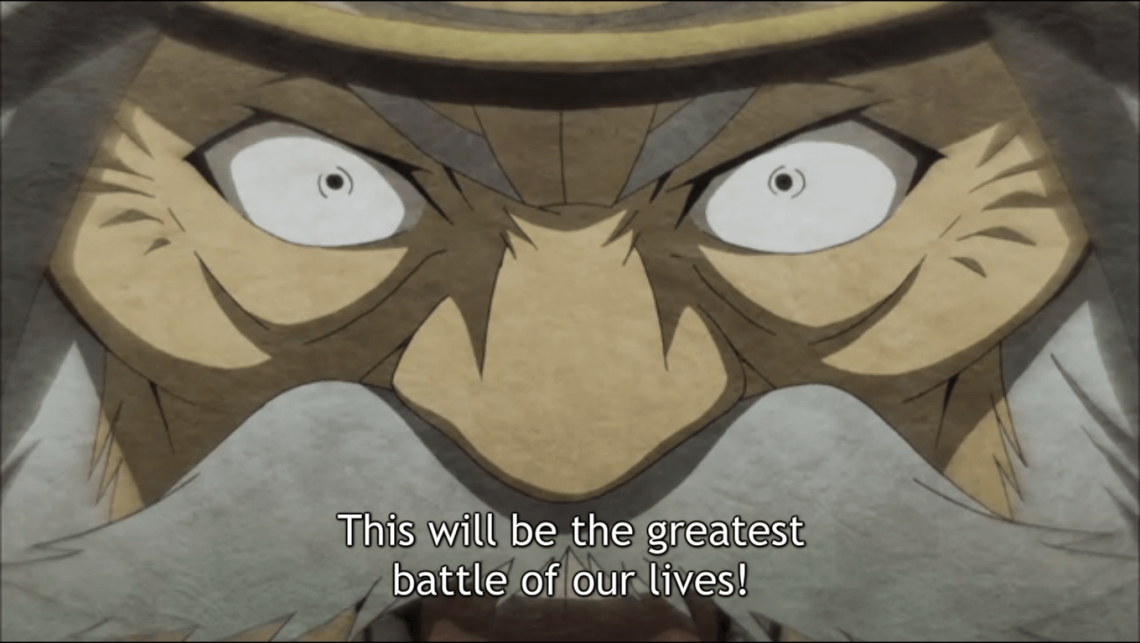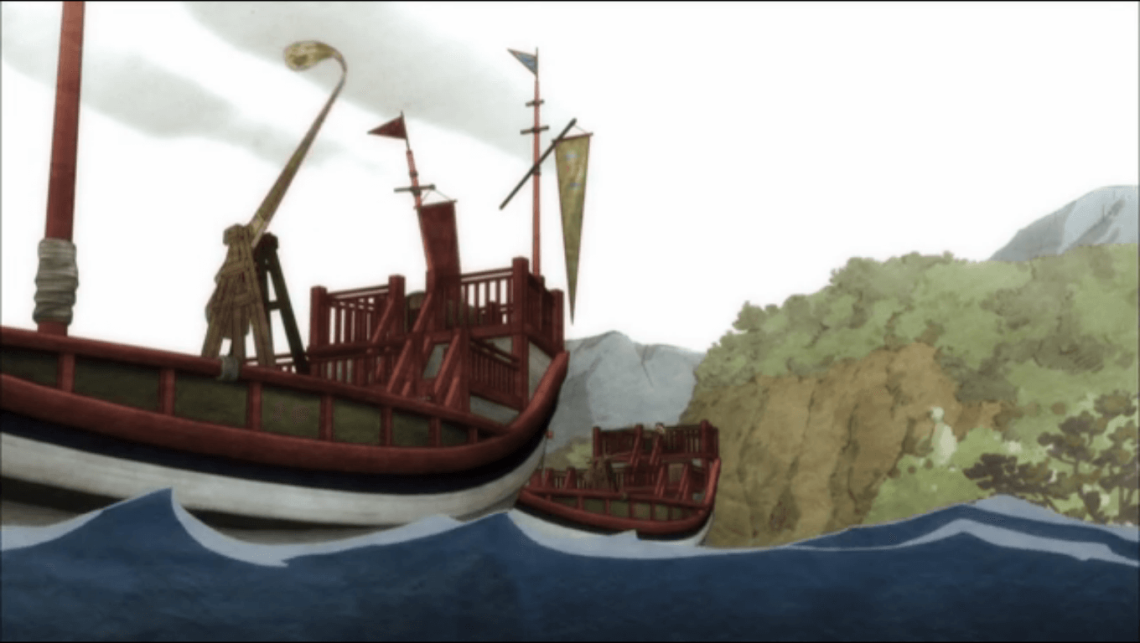As you probably know, I…oh geez, how do I put this lightly…uh, have an affinity for historical strategy games. I’ve been made fun of a lot for my Civ addiction, but I’m also really into some of the games by Paradox Interactive, like Europa Universalis IV and Crusader Kings II. What you might not know is that this is a fairly recent addiction, and that I only got into the genre about four years ago. Funnily enough, getting into the genre also got me into something I never thought I’d get into: history itself. Now, okay, I’m not that into history, but I’ve come to quite enjoy doing some quick reading on some of the history related to these games. It’s not a lot, but considering history used to be one of my least favourite (and worst) subjects in school, it’s a pretty big turnaround.
Bring on Angolmois: Record of Mongol Invasion, a summer 2018 anime documenting the first invasion of Japan by the Mongol Empire in 1247. The story follows a group of exiles, including main character Kuchii Jinzaburō, are conscripted into the defense force of Tsushima Island, a small island off the south-west coast of Japan where the the Mongols first made landfall. What originally drew me to this show was the chance to learn a bit more about the feudal Japan, but I ended up finding a show I really liked. Is part of that my interest in history? Eh, maybe. But it’s also a straight-up good anime, and one I’d suggest perhaps to anime fans, and definitely to fans of historical (semi-)fiction. Oh, and this is your first and only spoiler warning.
One of the very nice things about Angolmois is that it’s not very anime-y. The tropes are definitely there, samurai or not I can’t imagine one guy chopping through dozens of soldiers defending their army’s command centre, but such instances are few and far between. Furthermore, they serve a purpose other than just making the characters look bad-ass. The previous crazy ninja skills actually had a basis in military strategy (and he did have help, even if it’s just said and not shown). The Japanese army had been routed in that day’s battle, and their leader and his son had been killed, their heads put on pikes. Jinzaburō‘s attack on the enemy command was a calculated maneuver to retrieve the heads, so the Mongols couldn’t parade them about the battlefield the next day, decimating the Japanese army’s morale. Which also brings us to how well violence is used in the show. It is about war after all, and can get very violent at times. But, once again, the violence is not anime-y. It’s not violence for the sake of violence, it’s violence to remind the viewer that this is in fact war. People get hurt. People die. Each battle and each death serves a purpose. Even if it’s just some random infantrymen falling, their deaths, and the way they died, help to show the direction that the battle is going. If you’re not a fan of violence, Angolmois might not be for you. But if you’re a fan of good violence (if there even is such a thing), it’s definitely worth checking out.

The anime is also very good on emotion. When the local Lord and his son were killed, it was really sad. These are characters we’d only known for a little while, but the writers did an excellent job of showing their deaths. After an initial victory against a small advance force of Mongols, the small number of Tsushima soldiers are forced to retreat as the enemy begins their main assault. The Lord stays behind to give his men time to flee, but is quickly killed by the enemy army. We hadn’t known him long at this point, but the way he led his troops, and the way he died, gave his death a lot more meaning than such short-lived characters usually get. When his daughter and officers learn of how he died (he was the one that the Mongols beheaded), it’s really rough. His daughter learning of the deaths of her father and brother were hard enough, but that’s also your standard “literally every single work of fiction ever” type stuff. What really got to be was the reactions of his officers. These guys aren’t exactly hardened soldiers, as Japan hadn’t had any major conflicts in about half a century at this point, so no one really had any battle or command experience. They are still soldiers though, and ones expected to be the backbone of their army, and it was hard to see them drop to their knees in tears at the sight of their fallen leader.
Like any anime however, Angolmois isn’t without its problems. I’ll stick the high levels of violence in this category, but that’s really only a problem if you don’t like to see violence. Like I said, it’s violence that’s executed very well, and the show would not be as good without it. However, if you’re not into people dying left, right and centre, this might be one that you want to pass up. Second, is the paper filter over everything, which I’m sure you can see if you just take a quick glance at any of the pictures in this article. It’s…weird, and can be at times very distracting, especially over top grainy things like wood or hair. And taking place in the 1200s, the show has lots of wooden buildings, and people with lots of hair. By far the worst part though, is that it’s just a filter on top of non-paper grain art. This means that whenever the camera underneath pans across anything, the filter stays in the same place, and it just doesn’t look good. Cards on the table, I actually like the paper art style. It has an interesting look, and helps make the anime feel like a story from 800 years ago. It needs to be toned down a bit however, especially in places where it’s distractingly obvious, and it needs to be part of the actual art. None of this slap it on top of finished work and you’re done crap.

Angolmois: Record of Mongol Invasion is a good anime, but it’s not for everyone. If you don’t like violence, maybe skip it. If you do like violence but wish the characters would shut up about military strategy and just get on with the fighting, you might want to watch some other anime with fighting. There are a lot. If you can’t get past that paper filter, well try to, because it’s a really good anime underneath. But if this is a show that interests you at all, watch it. We’re barely halfway through 2018, and only three episodes into the show at the time of writing, but I’m more or less ready to call this my top show of the year. We’ll, maybe not the best of 2018, but the best new show of 2018. And you know what? I’m willing to bet I like it more than some of the returning shows this year as well.

The filter is insane. I can’t comprehend the decision on giving that the go ahead. It would have been a solid show otherwise.
LikeLike
“By far the worst part though, is that it’s just a filter on top of non-paper grain art. This means that whenever the camera underneath pans across anything, the filter stays in the same place, and it just doesn’t look good. Cards on the table, I actually like the paper art style”
– Yes, the paper style is aesthetic but the filter needs to go away (it does not so far). It felt like watching a video with a bad instagram filter in it. Haha! Other than that, I love the show which for me, speaks a lot since I hate historical samurai ones.
LikeLike